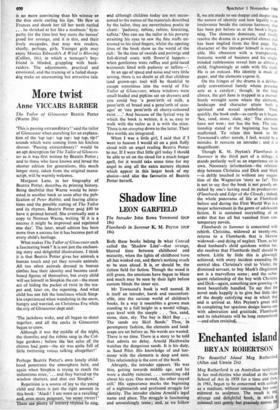Enchanted island
BRYAN ROBERTSON
The Beautiful Island Meg Rutherford (Allen and Unwin 21s)
Meg Rutherford is an Australian sculptress in her mid-thirties who studied at the Slade School of Art in 1958 for a time and then, in 1961, began to be concerned with collage
as a medium, without renouncing her conemitment to sculpture. The result is strange and delightful book, in which minimal text gently but precisely- moves narrative forward by a single phrase to each page. It is, of course, what happens on the facing page that is strange, for cathedrals and palaces, castles and memorials are towed across deserts, along swaying bridges straddling vast ravines, over (and under) great oceans to end up on an idyllic island where the bizarre array of buildings is put to unexpected uses. The way in which these disconcerting proces- sions are achieved visually is indeed enchanting. But, having implied something of the book's charms, one should add that the illustrations are quite masterly, and the publisher's claims that they are 'comparable only with the works of Max Ernst and Rene Magritte' are, for once, exact.
They are not aimed at the balefully surrealist mood sustained by Ernst in his own illustrations which, like Meg Ruther- ford's, gain much of their icy, still atmos- phere from the severity of their engraved line, whether Ernst's own or that of the nine- teenth-century illustrators from whom he selected material for collage. But the underlying activity, frozen into deceptively calm repose, of tension and poetic drama which floods through all the work of Magritte can also be found in Meg Ruther- ford's collages: as much or as little as the more explicit dislocations of time, place and identity which occur rather more wildly in the work of Ernst. The plain fact is that Meg Rutherford is an original artist on a very high plane; lofty comparisons are in order, but she establishes her own position.
My only cavil, hopefully on behalf of the seven to ten year olds who would possibly most relish these exotic, elaborately detailed, and totally engrossing images, is over the question of the rather meagre text supplied as a relief from the intricacies of the pictures. The words just suffice; the action is constant; each phase is properly and clearly labelled; but what appears is not much more than a series of captions placed on the interleaving blank pages. Still, Meg Rutherford is hardly to be blamed for concentrating so narrowly on pictures which are true works of narrative art illustrated demurely, as it were, by simple phrases of text. Where aim the words, after all, to match the impact of a castle being towed across a river in a mountainous landscape? Or improve upon the scene of chairs, isolated in a desert and apparently regard- ing with equanimity the spectacle of two embattled rhinos?















































 Previous page
Previous page